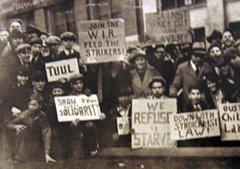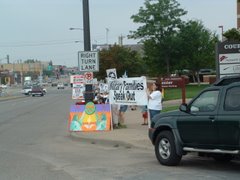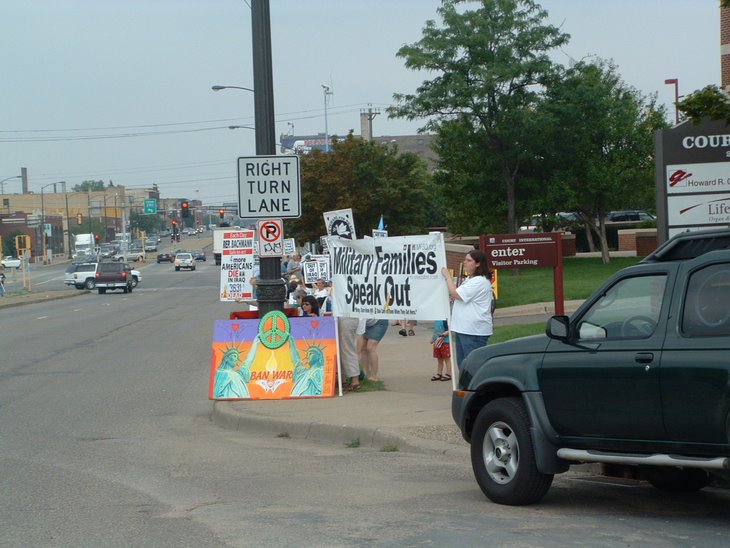Note: This is a guest blog by Brian McAfee of Muskegon, Michigan. I note the "Dream Act" is referenced at the end... I want it understood that I do not support the "Dream Act" in its present form because its primary intent is to bolster and strengthen the United States military... as far as I am concerned, the "Dream Act" is one more Obama fiasco that serves to divide people by including something that is helpful into a piece of legislation that is mostly an attack on the working class... I invite any and all responses for publication including from Brian. Other than the Dream Act, I share Brian's concerns about immigration which I think he has an excellent take on this issue. Alan L. Maki
(Please note: Brian has asked me to include here that he only supports the Dream Act without the inclusion for the military, and this is my position, too. Alan L. Maki)
Brian submitted this response to my "note" above:
I also support the passage of the DREAM act:
During the first six years, the immigrant would be granted "conditional" status, and would be required to graduate from a two-year community college or complete at least two years towards a 4-year degree, or serve two years in the U.S. military. After the six year period, an immigrant who met at least one of these three conditions would be eligible to apply for legal permanent resident status. During this six year conditional period, immigrants would not be eligible for federal higher education grants such as Pell grants, but they would be able to apply for student loans and work study.[11]
If the immigrant did not meet the educational or military service requirement within the six year time period, their temporary residence would be revoked and they would be removable. They also must not commit any crimes other than those considered non-drug related misdemeanors, regardless of whether or not they have already been approved for permanent status at the end of their six years. Being convicted of a major crime, or drug-related infraction would automatically remove the six year temporary residence status and they would be subject to deportation.[citation needed]
If the immigrant met all of the conditions at the end of the 6-year conditional period, they would be granted permanent residency, which would eventually allow them to become U.S. citizens.
An estimated 65,000 immigrant students[12] graduate from high school each year.[13] However, it is not known how many of those were eligible go on to complete the further requirements. It is estimated that currently only 7,000–13,000 college students nationally can fulfill the further obligations, a drastic drop from the already limited pool of those initially eligible.[14]
The bill also restores the option for states to determine residency for purposes of higher education benefits by repealing Section 505 of the Illegal Immigration Reform and Immigrant Responsibility Act (IIRIRA) of 1996 (8 U.S.C. 1623).[9] The majority of states interpret this provision as disqualifying unauthorized students from certain higher education benefits such as in-state tuition rates.[15] Some states have enacted laws aimed at making unauthorized state residents eligible for in-state tuition rates without violating this IIRIRA provision.[16] However, some students paying out-of-state tuition have filed lawsuits in these states, claiming state education officials violated this federal law.[17] Repealing this provision would provide states the ability to choose their own residency requirements for higher education benefits.
MYTH #1: Illegal aliens take American jobs.
FACTS: For the most part illegal aliens work jobs Americans simply do not want. They are farm workers, janitors, chambermaids, busboys, dishwashers, gardeners, nannies, and household domestics. Those are not the careers most Americans seek. The jobs immigrants perform in the U.S. are usually minimum wage with no benefits. They do the lousy, back-breaking work Americans can but refuse to do.
MYTH #2: Illegal aliens don't pay taxes
FACTS: The majority of illegal aliens pay the exact same taxes you and I pay. Most illegal aliens work for employers who don't know they are illegal or, possibly suspect they may be illegal but don't want to know for sure. As a result, the typical employer of an undocumented worker deducts all the federal income and other taxes from all his employees -- legal and illegal alike.
MYTH #3: Illegal aliens don't learn English or assimilate
FACTS: The typical Mexican who grew up in Mexico attended school there for only 3 to 6 years. As a result, most of the older Mexicans who are here only speak their native language at a basic level. As a result, it is tremendously difficult for many of those adults to learn fluent English. The children of those older immigrants, however, go to school in the U.S., are immersed in English-speaking American culture, and virtually all speak English. Those second-generation Mexicans speak English and assimilate into U.S. culture the same way the Irish, Italians, Japanese, and every other group of new immigrants have in the past.
MYTH #4: Illegal aliens don't contribute to the U.S. economy; they just come here to get on welfare.
FACTS: Illegal aliens contribute immensely to the U.S. economy. They work hard and perform the essential jobs that are vital to keeping the U.S. economy moving forward. They pay taxes and consume goods -- from cars and gas to groceries and houses -- and buy services which, in turn, benefit U.S. citizens selling those goods and services.
As for illegal aliens signing up for welfare, U.S. law strictly prohibits those here illegally from obtaining welfare, food stamps, or any other type of public assistance.
MYTH #5: Illegal aliens can and should apply to legally come in to work in the United States.
FACTS: Great idea, except it just happens to be impossible. The present system for employment-based immigration allows only 5,000 low-skill Green Cards per year for the entire United States.
MYTH #6: Illegal aliens are responsible for a disproportionate percentage of crime.
FACTS: Numerous reputable studies have shown that the problem of crime in the United States is not caused or even aggravated by immigrants, regardless of their legal status. Over the past few years, when someone is arrested the first question they are asked by the police after their name and address is, "Where were you born?" If the answer to that question is not "U.S.A." the Border Patrol is automatically contacted. The person, if undocumented, is immediately placed into the deportation process. As a result, undocumented individuals have a very high incentive to not break the law.
MYTH #7: Illegal aliens abuse the health care system.
FACTS: The general rule is that those who are here in undocumented status are not entitled to any taxpayer funded health care. The exception to that rule is that those here illegally can get emergency medical treatment. A recent RAND corporation study states as follows: "The foreign-born (especially the undocumented) use disproportionately fewer medical services and contribute less to health care costs in relation to their population share."
MYTH #8: Illegal aliens can and should be ferreted out and deported from United States.
FACTS: This solution is not likely. The estimated 11 million undocumented individuals in the United States is equivalent to the entire populations of Washington, Oregon, and Idaho combined. It would be impossible to locate and deport that many people. Besides, millions of those adults unlawfully here have an estimated 4 million U.S. citizen children who the government would be required to find foster parents for if their parents were deported. Finally, if a magic wand was waved and all undocumented workers were gone tomorrow, it is highly unlikely that native-born Americans would do the lousy, backbreaking agricultural and other minimum wage/no benefits work that the undocumented do in the U.S. economy.
MYTH #9: The illegal alien problem would be fixed if we just completed the fence along the southern border.
FACTS: For every 15-foot fence there is a 16-foot ladder or a shovel that can dig underneath it. Besides, 40 percent of those undocumented in the United States -- about 4.4 million -- entered legally and overstayed their visas. The fence may help but it alone will not solve our immigration situation.
MYTH #10: The proposed immigration reforms in congress are just another "amnesty."
FACTS: Amnesty is defined as "Forgiveness without penalty." All of the immigration reform proposals require payment of a fine (maybe $1000), learning some English, paying all back taxes (if any are owed), and going to the back of the line before obtaining Legal Permanent Residence status.
MYTH #11: Americans don't support immigration reform.
FACTS: When Americans are asked, "Do you support a legalization program that would allow those in the U.S. illegally to obtain legal status if they could meet the following requirements: a strong work history, no serious criminal convictions, no deportations, learn some English, pay all back taxes, pay a fine and go to the back of the immigration line," numerous polls have shown that 60 to 70 percent are in favor of such a solution to our immigration situation.
MYTH #12: Denying illegal aliens driver's licenses will help solve the immigration problem.
FACTS: That's crazy. The overwhelming reason why the undocumented are here is to work. Almost all workers in America need to drive to get to work. Workers, especially farm workers, typically must travel long distances to get to and from work. From the point of view of the public safety of U.S. citizens, it is much better if everyone driving on the highways has completed a driver's course and has qualified for a driver's license.
MYTH #13: If every employer was required to verify the social security number of every employee, we could solve our illegal immigration situation.
FACTS: Well, yes, sort of. A mandatory social security verification system is a good idea but only if there is an earned legalization program put in place simultaneously. Under current circumstances, requiring social security verification without earned legalization would create chaos in many sectors of the U.S. economy. It is estimated that 50 to 60 percent of farm workers are undocumented and the percentage of undocumented workers in many other low-skill, minimum-wage, no benefits jobs -- such as dishwashers, gardeners, dairy workers, janitors, chambermaids -- is also very high.
MYTH #14: A law like the new law in Arizona would solve our immigration situation.
FACTS: The Arizona law is an overreaction and can best be compared to how we overreacted in 1942 when the U.S. government placed all west coast Japanese in internment camps. Thirty percent of Arizona's citizens -- more than 2 million people -- are Hispanic and legal. The Arizona law is vague and invites discrimination against them.
MYTH #15: Those who are upset about the current immigration situation are racists.
FACTS: Of course, some racism does exist in this debate. But for the most part the American public is frustrated and angry that our elected officials prefer to play "gotcha" politics with this difficult and controversial issue rather than addressing it in a mature, common sense manner. Most Americans recognize that most of the people here illegally are working hard at low-end jobs, and they believe the politicians should find some rational solution to this very contentious matter.
The solution to our immigration dilemma will only come from comprehensive immigration reform. That reform must include four parts:
1) Secure the southern border
2) Allow those here to apply for earned legalization
3) Require all employers to verify the immigration status of their employees
4) Allow some flexible number of low-skill Green Cards in the future in light of the needs of the U.S. economy.
- Immigration can lead to an exchange of values, knowledge, expertise and perspectives. Because of immigration, people are exposed to diverse languages and cultures that are different from their own, adding to the richness of any given society.
The Economy
- Whether immigrants make up the brains behind research and technological development or help meet a country's demand for labor, they are often seen as a boon to the economy of the recipient nation. Many immigrants represent the most intelligent, hard-working and ambitious people of their native countries. Allowing them to bring their talents and skills to another country can be enriching for immigrants and the recipient nation. In addition, immigrants add to the country's consumer base, helping the economy.
Fighting Poverty
- While some believe that the jobs and wealth of a country are its own private property, others believe immigration is a key to opening the global market and spreading wealth into less-developed countries. Thus, immigration can be viewed as a valuable tool in combating world poverty.
Keeping it Legal
- Allowing for a steady flow of legal immigration minimizes the incentive for illegal immigration. By reducing or cutting off the flow of legal immigration, illegal immigration becomes more commonplace, leading to a range of problems from creating a drain on taxpayer services to an increase in crime rates.
Positive Image
- A welcoming nation that allows for reasonable immigration and treats immigrants fairly will more likely be known for such virtues and respected throughout the world.
Cultural Exchange
Immigration, A Perennial Issue Of Concern In The U.S.
By Brian McAfeeThe issue of immigration was brought to the forefront recently by Arizona’s discriminatory immigration law SB 1070, which would require police and other public officials to ask all or any Latino looking people to show their ID’s. This demonstrates an attitude oriented towards criminalizing immigrants in general and a hostile outlook towards Hispanics in particular. The anti-immigrant attitude was also evident in Utah a few months ago when a list was published and widely distributed with the names and personal information of 1,300 supposedly illegal immigrants concerning which some were actually born in the U.S., but happened to have Hispanic looking names. The people that created the list signed it “anonymous”, i.e.- cowards.
At the same time, many in the right wing of America are targeting the 14th Amendment, which states “all persons born or naturalized in the United States, and subject to the jurisdiction there of, are citizens of the United States and of the states where in they reside.” They (the right) have dubbed them “anchor babies” and, in effect, wish to criminalize babies.
Understandably, there is a heightened climate of fear that many immigrants experience due to such extreme animosity being directed toward them. Yet, immigrants have nearly always been a perennial scapegoat of the right. Indeed, they make easy targets as they often have little or no political clout and generally cannot fight back through legal means.
Racism, I believe, is one of the fundamental components of the hostility towards immigrants. I don’t really like to use the word “race” or overly emphasize “racism” as a factor, especially as I believe that “race” is a misnomer in that all of us are of the same race, the human race. I use it only because it is in the common vernacular while often used to point out an imaginary great divide linked to ethnic variance and supposed negative traits that are assigned to people who superficially appear different.
My interest and activism on behalf of this and similar issues began about 1980 when I lived in California. Then I was involved with the anti-interventionist movement that was against U.S. policies of backing right wing dictatorships, and training militaries and death squads from El Salvador and Guatemala, as well as throughout much of Latin America. I was also active in CISPES, the Committee in Solidarity with the People of El Salvador.
At the time, the group was opposed to U.S. operations that supported government leaders and armed forces involved in widespread imprisonment, torture and murder of innocent civilians to prop up a corrupt regime favoring U.S. business interests. Due to the resultant turmoil in their land, many Salvadorans, throughout the 80′s and into the 90′s, came north as refugees and were helped by the sanctuary movement that sheltered many of these illegal aliens.
Movement members understood that, if the refugees were deported to El Salvador, they would likely be found and killed by the Salvadoran government/death squads whose commanders the U.S. funded and trained at the School of the Americas in Georgia. In relation, El Salvador had 75,000 killed and, concurrently, Guatemala had 200,000 civilians killed in the 80′s and 90′s.
All considered, many refugees, aside from those from El Salvador, came to the U.S. during that period. Yet because of our government’s ratification of their nations’ brutal regimes, our public officials showed indifference to their story and hostility to their needs at the time.
Later on when Newt Gingrich and the Republicans introduced their Contract with America, many of us rejected its viewpoints. We noted, amongst other unacceptable positions, its ratification of a strong anti-immigrant stance, one that instilled a great deal of anxiety among many immigrants, including my wife who is from Thailand.
Understandably, many immigrants from all parts of the world feared deportation in relation to this ugly contract. So they worked to quickly obtain U.S. nationality and, representing a fairly common mix for that era, there were about 300 new citizens comprised of approximately 70% Latin Americans, 20% Asians, and 10% Europeans and Africans during one of the many citizenship ceremonies taking place then.
Meanwhile, I, as always, have a positive attitude about immigration and the ethnic mix of our country. I view both as a good occurrence, especially as newcomers and people with diverse cultural backgrounds bring a fresh perspective to many varied issues that concern us all. They also often provide valuable goods and services that vitalize the economy and strengthen community ties.
To learn more details about this topic, please refer to DREAM Act – Act On A Dream, Tom Roach’s Myths muddle the immigration morass | OregonLive.com, David A. Sylvester’s Reagan’s Refugees: Why Undocumented Migrants Have a Right to Work Here and Michael O’Brien’s Newt Gingrich Outlines New ‘Contract With America’.
I welcome any comments and can be reached at brimac6@hotmail.com.











































































































